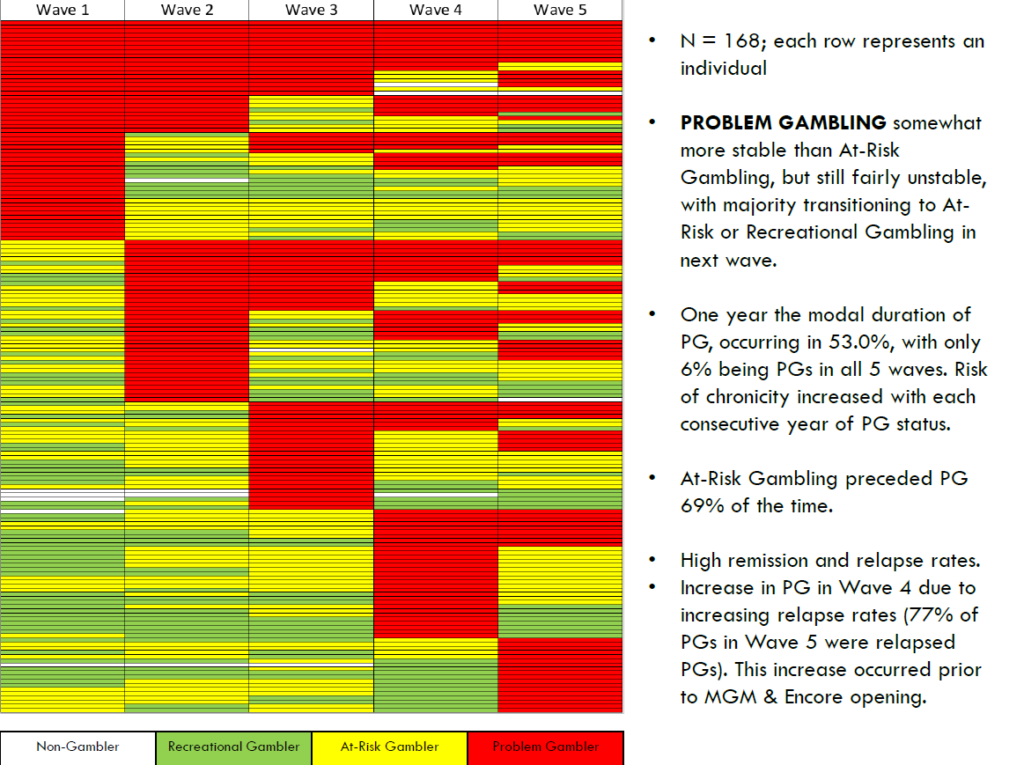Massachusetts Leads The Way On Gambling Research

An overlooked aspect when Massachusetts legalized casino gambling was the requirement for numerous studies written into the law. These studies cover everything from the local economic impacts of casinos to problem gambling trends in the Commonwealth.
During a webinar, a University of Massachusetts Amherst team laid out some of the from an ongoing research project into problem gambling in Massachusetts. The first-of-its-kind study, (MAGIC), provides a look at problem gambling through the lens of a six-year cohort study.
The study, commissioned by the (MGC), is part of its robust research project to gauge the impacts of introducing casinos in the state. And with legal sports betting on the horizon, this is a subject Massachusetts will have to stay ahead of.
As a press release notes, “MAGIC was the first major cohort study of gambling in the United States, surveying the same individuals over six years to understand more about how gambling and problem gambling develop and progress, and how remission from problem gambling occurs.”
A Look at the Cohort Study Findings
The webinar began with an introduction by Rachel Volberg, principal investigator of the and MAGIC studies, followed by MAGIC co-lead investigator Robert Williams’s presentation. The webinar culminated with a panel discussing problem gambling research and prevention efforts across the Commonwealth.
Massachusetts Casinos are Doing What They Were Meant to Do
One of the primary reasons for legalizing casino gambling in Massachusetts was to capture the casino spend from residents going out of state.
On that front, legalization has been a success. According to the study, out-of-state casino gambling fell from 33% in 2013-14 to 16% in 2019.
The findings revealed evidence that the state has been successful in its goal to “repatriate” Massachusetts dollars previously spent at casinos in nearby states. “This is good news,” Williams said. In addition, the introduction of casinos “had no negative impact” on lottery participation.
Problem Gambling Is Fluid
The research also shows that participants shifted in and out of the problem gambling category.

As the chart shows, there is an influx of problem gamblers in each wave of the survey, but many revert to at-risk and recreational gamblers in subsequent waves, although recidivism increases in successive waves.
For example, only about 50% of Wave 1 problem gamblers were problem gamblers in Wave 2. The Wave 1 problem gamblers that remained in the problem gambling category continued to decline in each subsequent wave. However, by Wave 5, many had relapsed, and as the chart states, 77% of problem gamblers in Wave 5 were relapsed problem gamblers from previous waves.
As the press release for the MAGIC study notes:
“The four gambling categories – non-gamblers, recreational gamblers, at-risk gamblers and problem gamblers – remained relatively stable over the study period, with about 70% of participants identifying as recreational gamblers. About 14% of the 3,000-plus participants from across the state were non-gamblers; about 12.5% were at-risk gamblers; and about 3.5% were problem gamblers.
“Nearly 20% of the at-risk gamblers subsequently become problem gamblers, but “a much more common route” was moving back to recreational gambling, the study found.”
A DFS Bump in Problem Gambling?
One of the data points that jumped out at me was a bump in problem gambling before Massachusetts casinos opened (and sans an expansion of gambling in neighboring states), as the rate of problem gambling within the cohort rose from 2.5% to 3.1% in 2015. Interestingly, the addition of casinos has only brought that number up to 3.8%.
The 2015 rise may not be as inexplicable as it seems. It coincides with the increase in popularity of daily fantasy sports and increased coverage of online gambling.
, “Findings suggest that DFS players are characterized by high gambling frequency and problem severity and comorbid problems, notably suicidal ideation.”
Policy Recommendations and Mitigation
The research team issued the following policy recommendations based on their findings:
- Limit gambling advertising;
- Expand focused educational efforts that promote knowledge, motivations, and attitudes conducive to responsible gambling;
- Screen people with substance abuse and mood disorders for gambling behaviors;
- Encourage problem gamblers to seek treatment.
As Williams emphasized, “there is no ‘silver bullet’ to prevent problem gambling. Rather, a wide array of educational and policy initiatives is needed to address the multifaceted biopsychosocial” causes.
According to the press release, “The study identified more than 100 individual, social, and environmental variables that predict and mediate the development of future gambling and problem gambling.”
Along with well-known factors from having lower income, being male, having substance abuse or mental health challenges, gambling-related variables, such as biggest loss or win in a single day, had the strongest correlation to developing a gambling disorder.
“Each problem gambler has a unique array of risk factors,” Williams said. “You need to tackle problem gambling from a multidirectional way as well.”







